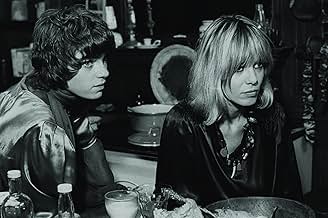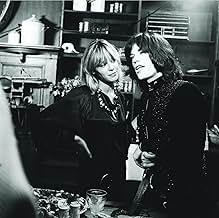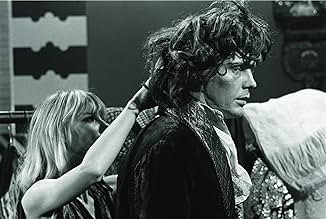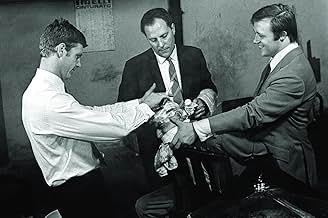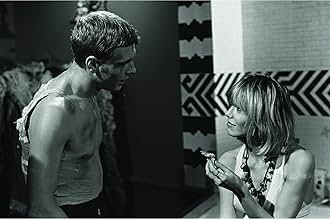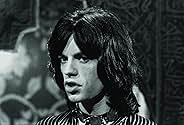CALIFICACIÓN DE IMDb
6.7/10
12 k
TU CALIFICACIÓN
Un violento gángster del este de Londres sufre una transformación de identidad mientras se esconde de sus antiguos colegas en la casa de una estrella de rock bohemia harta y sus dos novias.Un violento gángster del este de Londres sufre una transformación de identidad mientras se esconde de sus antiguos colegas en la casa de una estrella de rock bohemia harta y sus dos novias.Un violento gángster del este de Londres sufre una transformación de identidad mientras se esconde de sus antiguos colegas en la casa de una estrella de rock bohemia harta y sus dos novias.
- Dirección
- Guionista
- Elenco
- Nominada a1 premio BAFTA
- 1 nominación en total
Michèle Breton
- Lucy
- (as Michele Breton)
Anthony Morton
- Dennis
- (as Antony Morton)
Kenneth Colley
- Tony Farrell
- (as Ken Colley)
Edmond Bennett
- Detective Sergeant
- (sin créditos)
Helen Booth
- Noel's mum
- (sin créditos)
John Caesar
- Ticket Clerk
- (sin créditos)
Jay Denyer
- Constable
- (sin créditos)
- Dirección
- Guionista
- Todo el elenco y el equipo
- Producción, taquilla y más en IMDbPro
Opiniones destacadas
This is probably one of the best cult movies ever made. I have seen it about 20 times now and even the last time, it was still not boring and I stayed up late again to watch it at 3 in the morning (even though I have it on video). "Performance" shows James Fox in a part you would never expect from him. The mobster with the secret past and deep dark secrets. Violent and with a "no mercy" attitude. Very impressive. Mick Jagger debuts as an actor in this picture and you can see he wants to do well in the beginning. I know the movie was shot chronologically and Jagger seems to be growing as an actor in each scene. The most impressive performance is the performance German/Italian actress Anita Pallenberg is giving here. As the Jagger's character says in the movie: "The only performance that makes it, that really makes it, that makes it all the way, is the one that achieves madness!" And Anita does just that. She is beautiful, decadent, dangerous, high and grounded and very much herself as Pherber. If you watch this movie, you should really try and focus on her, because she is full of surprises. French teen actress Michèle Breton only starred in this movie and the attention is drawn away from her completely by Pallenberg. That is a shame, because Breton does have some very strong scenes, like the one with Pallenberg when they are talking about the gangster. You can see that both Breton and her character are not sure what they are yet: are they children or young women? This movie clearly deserves 10 out of 10!
As the title might suggest, Performance (1970) is a film to be experienced, as opposed to simply endured. At its most basic level, the film can be seen as an experiment into the nature of personality, role-playing, character and the lines between fact and fiction, reality and fantasy; all blurred together by a heady cocktail of sex, drugs and rock n' roll that is representative of the late 60's art-scene that writer and co-director Donald Cammell was very much a part of. For many it will have no doubt become something of a dated relic; a film from the days when East End gangsters were all sharp-suited mother's boys or closeted homosexuals with Jags' and boxing clubs or 60's radicals with beards in bed-sits dropped acid and strummed endless drones about the doors of perception on electric guitars. Others will see it for what it truly is; a disorientating hall of mirrors of psychology and satire - part Borges, part Carroll - as Mick Jagger's self-destructive rock star becomes a sort of white rabbit figure; leading exiled gangster James Fox into a wonderland of psychological manipulation, mind-games and more.
On a secondary level of content and presentation, Performance can also be seen as a playful subversion of the codes and conventions of early gangster cinema; extending on certain well-worn characteristics of 40's film-noir - with the idea of a disgraced hood forced to hide-out after a botched job gives way to the threat of mob retaliation - whilst creating a continually evocative underworld environment that is rife with a number of recognisable references to the iconic gangland milieu of London's East End. This particular period setting is later contrasted and eventually broken down by the second half of the film, in which a combination of bohemian squalor and 60's decadence erode the carefully created facade that these troubled and enigmatic characters - "performers" even - have exploited in order to progress within their disparate social environments. The lines are further blurred by the use of drugs, which again, parallel the emotional landscapes of Lewis Carroll, as well as the more potent ideas of sex and sexuality, which are here presented as being part of a greater performance in itself.
The film is littered with presentations of sex - both heterosexual and homosexual - and always loaded with the threat of both physical and psychological violence, power and manipulation. The sex is a continual distortion; neither erotic, nor titillating, and seemingly inspired by the paintings of Francis Bacon or Domenico di Michelino. It works in the creation of a heightened atmosphere that becomes continually more oppressive and dangerously claustrophobic as the film develops; with the kaleidoscope of images, sounds and colours all blending and blurring between extended philosophical discussions, violence and transfiguration. From here the film shows the subtle symbiosis between the self-aware rock-star and the naive gangster, as sex and drugs are again combined to break down the boundaries of personality and the literal mirroring between life and death. There are all kinds of different ways that we, as an audience, can interpret these ideas and the relationship between the characters; as Cammell - here in close-collaboration with co-director and cinematographer Nicholas Roeg - creates a continually fascinating atmosphere that is punctuated by abstract thought and dark, surrealist imagery.
As a work of artistic expression and cinematic experimentation Performance is a film that needs to be experienced. It is not only notable as a deep, penetrating expose into the human psyche and the dangerous places that narcissism and self-delusion can carry us when the walls of reality have slowly broken down, but as a time capsule to the creative spirit of the 1960's and a brief bohemian subculture that I for one find incredibly interesting. The film also manages to capture the raw energy and quiet sexuality of Jagger before he became an insufferable cliché (all gyrating, geriatric hips swinging to a packed-out football stadium as he saunters through possibly the 100,000,000th performance of Gimme Shelter), with the seductive energy and shaman-like otherworldliness instead creating a character that is self-aware and clearly self-referential, and yet - so perfectly matched against the brooding uncertainty of Fox's wayward gangster. Likewise, the art-pop, drug culture and obvious psychedelic influences never overwhelm the story; instead feeling absolutely germane to the scene that Cammell and Roeg were attempting to explore and to the themes expressed within the subtle subtext of Cammell's strange and suggestive script.
In hindsight, Performance can be seen as the point in time at which the psychedelic experimentation, expression and drug-culture of the 1960's was allowed to envelope the cinematic medium; extending on the more exciting and progressive films that had been emerging from places like France, Japan or the Czech Republic throughout the years leading up to 1967, and finally creating a complete symbiosis between content, theme, character and presentation that was socially progressive and entirely relevant. If America had films like Easy Rider (1969), Medium Cool (1969) and Zabriskie Point (1970), then we had Performance and 'If...' (1968). And if the latter remains a truly defining masterpiece of British film-making and a testament to the unsung greatness of director Lindsay Anderson, then Performance is the essence of the scene preserved as a sort of cinematic reflection; where the underground met the mainstream and the experience was allowed to take control.
On a secondary level of content and presentation, Performance can also be seen as a playful subversion of the codes and conventions of early gangster cinema; extending on certain well-worn characteristics of 40's film-noir - with the idea of a disgraced hood forced to hide-out after a botched job gives way to the threat of mob retaliation - whilst creating a continually evocative underworld environment that is rife with a number of recognisable references to the iconic gangland milieu of London's East End. This particular period setting is later contrasted and eventually broken down by the second half of the film, in which a combination of bohemian squalor and 60's decadence erode the carefully created facade that these troubled and enigmatic characters - "performers" even - have exploited in order to progress within their disparate social environments. The lines are further blurred by the use of drugs, which again, parallel the emotional landscapes of Lewis Carroll, as well as the more potent ideas of sex and sexuality, which are here presented as being part of a greater performance in itself.
The film is littered with presentations of sex - both heterosexual and homosexual - and always loaded with the threat of both physical and psychological violence, power and manipulation. The sex is a continual distortion; neither erotic, nor titillating, and seemingly inspired by the paintings of Francis Bacon or Domenico di Michelino. It works in the creation of a heightened atmosphere that becomes continually more oppressive and dangerously claustrophobic as the film develops; with the kaleidoscope of images, sounds and colours all blending and blurring between extended philosophical discussions, violence and transfiguration. From here the film shows the subtle symbiosis between the self-aware rock-star and the naive gangster, as sex and drugs are again combined to break down the boundaries of personality and the literal mirroring between life and death. There are all kinds of different ways that we, as an audience, can interpret these ideas and the relationship between the characters; as Cammell - here in close-collaboration with co-director and cinematographer Nicholas Roeg - creates a continually fascinating atmosphere that is punctuated by abstract thought and dark, surrealist imagery.
As a work of artistic expression and cinematic experimentation Performance is a film that needs to be experienced. It is not only notable as a deep, penetrating expose into the human psyche and the dangerous places that narcissism and self-delusion can carry us when the walls of reality have slowly broken down, but as a time capsule to the creative spirit of the 1960's and a brief bohemian subculture that I for one find incredibly interesting. The film also manages to capture the raw energy and quiet sexuality of Jagger before he became an insufferable cliché (all gyrating, geriatric hips swinging to a packed-out football stadium as he saunters through possibly the 100,000,000th performance of Gimme Shelter), with the seductive energy and shaman-like otherworldliness instead creating a character that is self-aware and clearly self-referential, and yet - so perfectly matched against the brooding uncertainty of Fox's wayward gangster. Likewise, the art-pop, drug culture and obvious psychedelic influences never overwhelm the story; instead feeling absolutely germane to the scene that Cammell and Roeg were attempting to explore and to the themes expressed within the subtle subtext of Cammell's strange and suggestive script.
In hindsight, Performance can be seen as the point in time at which the psychedelic experimentation, expression and drug-culture of the 1960's was allowed to envelope the cinematic medium; extending on the more exciting and progressive films that had been emerging from places like France, Japan or the Czech Republic throughout the years leading up to 1967, and finally creating a complete symbiosis between content, theme, character and presentation that was socially progressive and entirely relevant. If America had films like Easy Rider (1969), Medium Cool (1969) and Zabriskie Point (1970), then we had Performance and 'If...' (1968). And if the latter remains a truly defining masterpiece of British film-making and a testament to the unsung greatness of director Lindsay Anderson, then Performance is the essence of the scene preserved as a sort of cinematic reflection; where the underground met the mainstream and the experience was allowed to take control.
Thirty years after its release 'Performance' still remains one of the most controversial movies of the 60s/70s. For many it is an arty pretentious bore that is only worth remembering for being a mother lode of imagery that has been mined extensively by MTV "talents" over the last twenty years. (Cammell/Roeg must be up there with Bunuel and Kenneth Anger as the most plagiarized source for rock video!)
For the rest of us 'Performance' could well be THE great movie of the psychedelic era, rivaled only by Antonioni's 'Blow Up' and Jodorowky's 'El Topo'. 'Performance' merges the hard boiled Cockney gangster world of the Kray twins (exemplified by James Fox's brutal Chas) with the freaks of the rock/drug world (Jagger's enigmatic Turner) and shows they have as much in common as they differ. Reality and fantasy blur, gender and personas get confused, and Chas and Turner become increasingly hard to tell apart.
All of this unfolds to an ultra-cool soundtrack of The Last Poets, Randy Newman, Jagger's lost classic 'Memo From Turner' and former Spector/Stones/Crazy Horse collaborator Jack Nietsche's Moog. Add to this plenty of sex, trips and Jorge Luis Borges references, and you've got yourself a mind-blowing movie experience!! Highly recommended to Grant Morrison fans.
For the rest of us 'Performance' could well be THE great movie of the psychedelic era, rivaled only by Antonioni's 'Blow Up' and Jodorowky's 'El Topo'. 'Performance' merges the hard boiled Cockney gangster world of the Kray twins (exemplified by James Fox's brutal Chas) with the freaks of the rock/drug world (Jagger's enigmatic Turner) and shows they have as much in common as they differ. Reality and fantasy blur, gender and personas get confused, and Chas and Turner become increasingly hard to tell apart.
All of this unfolds to an ultra-cool soundtrack of The Last Poets, Randy Newman, Jagger's lost classic 'Memo From Turner' and former Spector/Stones/Crazy Horse collaborator Jack Nietsche's Moog. Add to this plenty of sex, trips and Jorge Luis Borges references, and you've got yourself a mind-blowing movie experience!! Highly recommended to Grant Morrison fans.
Gangster James Fox (Chas) quite correctly exacts revenge on fellow bad-guy Anthony Valentine (Joey). But, this goes against the wishes of his boss Johnny Shannon (Harry) and so he has to go into hiding to prepare his escape from the country. The police are also looking for him although they don't figure at all in this film. Fox holes up in a house owned by faded rock star Mick Jagger (Turner) which he shares with a couple of druggy hippie chicks – Anita Pallenberg (Pherber) and Michèle Breton (Lucy). These three swap philosophies and indulge in a spot of identity swapping as well as a magic mushroom breakfast. Fox goes on a trip and he and Jagger truly become one. Meanwhile the gangsters are still searching for Fox
This film definitely has 2 parts – the beginning gangster story and then the unworldly lodgings with Jagger. The latter part of the film is quite amusing and both my wife and I commented that we should spend all our afternoons like that, especially when they are partying to the music. Let's all get a bit boho. I'm sure there are things to spot on another viewing. The cast are good although Johnny Shannon (Harry) doesn't quite cut it as top dog. His surname is Flowers, though, which suggests a pansy in charge – and the Krays are obviously given another nod in this offering by look-a-like gangsters.
Both lifestyles no longer survive – the gangster world is totally different as is the bohemian lifestyle on show. Who does mushrooms these days? Back in the day, though .
This film definitely has 2 parts – the beginning gangster story and then the unworldly lodgings with Jagger. The latter part of the film is quite amusing and both my wife and I commented that we should spend all our afternoons like that, especially when they are partying to the music. Let's all get a bit boho. I'm sure there are things to spot on another viewing. The cast are good although Johnny Shannon (Harry) doesn't quite cut it as top dog. His surname is Flowers, though, which suggests a pansy in charge – and the Krays are obviously given another nod in this offering by look-a-like gangsters.
Both lifestyles no longer survive – the gangster world is totally different as is the bohemian lifestyle on show. Who does mushrooms these days? Back in the day, though .
I missed this film when it came out over thirty years ago, and have looked out for it ever since. At last, after a rare showing on BBC's arts channel, it has proved to be well worth the long wait.
It is a complex film, starting and finishing as a gripping and violent gangster movie, with the more philosophical and erotic section with Jagger and Pallenberg slotted between the gangster elements. James Fox as gangster on the run is a revelation. Why didn't he get parts like this again? He is far more convincing than his contemporary Michael Caine in this kind of role, with a scary viciousness combined with his 'Jack the Lad' charm.
Although Mick Jagger and Anita Pallenberg don't seem to be playing anything more than themselves, they are perfect foils for Fox. As they embroil Fox in their weird games, the writers/directors Nicholas Roeg and Donald Cammell create brilliantly the mushroom-based trip that they take him on and through. The film also evokes a fascinating and nostalgic picture of late '60s London and is a reminder that the "swinging sixties" had their grimy and violent side. Overall, a great film that deserves far wider recognition.
It is a complex film, starting and finishing as a gripping and violent gangster movie, with the more philosophical and erotic section with Jagger and Pallenberg slotted between the gangster elements. James Fox as gangster on the run is a revelation. Why didn't he get parts like this again? He is far more convincing than his contemporary Michael Caine in this kind of role, with a scary viciousness combined with his 'Jack the Lad' charm.
Although Mick Jagger and Anita Pallenberg don't seem to be playing anything more than themselves, they are perfect foils for Fox. As they embroil Fox in their weird games, the writers/directors Nicholas Roeg and Donald Cammell create brilliantly the mushroom-based trip that they take him on and through. The film also evokes a fascinating and nostalgic picture of late '60s London and is a reminder that the "swinging sixties" had their grimy and violent side. Overall, a great film that deserves far wider recognition.
¿Sabías que…?
- TriviaAccording to Anita Pallenberg, one scene actually shows her shooting heroin, which she was just starting to get into at the time.
- Versiones alternativasIn most versions the voices of Johnny Shannon, John Bindon and Laraine Wickens have been overdubbed. This was because the actors' own voices were thought to be "too cockney" for non-UK audiences to understand. The 2007 Region 2 DVD (DY11687) features the voices of all three actors throughout the feature, none of the previous overdubs are present in this version.
- ConexionesFeatured in Memo from Turner (1970)
Selecciones populares
Inicia sesión para calificar y agrega a la lista de videos para obtener recomendaciones personalizadas
- How long is Performance?Con tecnología de Alexa
Detalles
- Fecha de lanzamiento
- País de origen
- Idioma
- También se conoce como
- The Performers
- Locaciones de filmación
- Productora
- Ver más créditos de la compañía en IMDbPro
Taquilla
- Presupuesto
- GBP 750,000 (estimado)
- Tiempo de ejecución1 hora 45 minutos
- Color
- Mezcla de sonido
- Relación de aspecto
- 1.85 : 1
Contribuir a esta página
Sugiere una edición o agrega el contenido que falta


